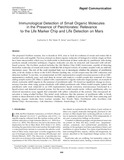JavaScript is disabled for your browser. Some features of this site may not work without it.
| dc.contributor.author | Rix, Catherine S. | - |
| dc.contributor.author | Sims, Mark R. | - |
| dc.contributor.author | Cullen, David C. | - |
| dc.date.accessioned | 2012-01-25T23:01:47Z | |
| dc.date.available | 2012-01-25T23:01:47Z | |
| dc.date.issued | 2011-11-17T00:00:00Z | - |
| dc.identifier.citation | Catherine S. Rix, Mark R. Sims, and David C. Cullen. Immunological detection of small organic molecules in the presence of perchlorates: relevance to the life marker chip and life detection on Mars. Astrobiology, 2011, Volume 11, Number 9, pp839-846 | |
| dc.identifier.issn | 1531-1074 | - |
| dc.identifier.uri | http://dx.doi.org/10.1089/ast.2011.0662 | - |
| dc.identifier.uri | http://dspace.lib.cranfield.ac.uk/handle/1826/6888 | |
| dc.description.abstract | The proposed ExoMars mission, due to launch in 2018, aims to look for evidence of extant and extinct life in martian rocks and regolith. Previous attempts to detect organic molecules of biological or abiotic origin on Mars have been unsuccessful, which may be attributable to destruction of these molecules by perchlorate salts during pyrolysis sample extraction techniques. Organic molecules can also be extracted and measured with solvent-based systems. The ExoMars payload includes the Life Marker Chip (LMC) instrument, capable of detecting biomarker molecules of extant and extinct Earth-like life in liquid extracts of martian samples with an antibody microarray assay. The aim of the work reported here was to investigate whether the presence of perchlorate salts, at levels similar to those at the NASA Phoenix landing site, would compromise the LMC extraction and detection method. To test this, we implemented an LMC- representative sample extraction process with an LMC-representative antibody assay and used these to extract and analyze a model sample that consisted of a Mars analog sample matrix (JSC Mars-1) spiked with a representative organic molecular target (pyrene, an example of abiotic meteoritic infall targets) in the presence of perchlorate salts. We found no significant change in immunoassay function when using pyrene standards with added perchlorate salts. When model samples spiked with perchlorate salts were subjected to an LMC-representative liquid extraction, immunoassays functioned in a liquid extract and detected extracted pyrene. For the same model sample matrix without perchlorate salts, we observed anomalous assay signals that coincided with yellow coloration of the extracts. This unexpected observation is being studied further. This initial study indicates that the presence of perchlorate salts, at levels similar to those detected at the NASA Phoenix landing site, is unlikely to prevent the LMC from extracting and detecting organic molecules from martian samples. | en_UK |
| dc.publisher | Mary Ann Leibert | en_UK |
| dc.title | Immunological detection of small organic molecules in the presence of perchlorates: relevance to the life marker chip and life detection on Mars. | en_UK |
| dc.type | Article | - |
Files in this item
This item appears in the following Collection(s)
-
Staff publications (SAS) [907]
